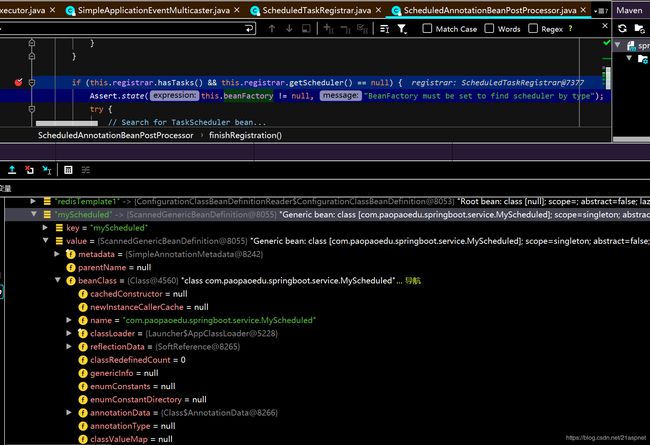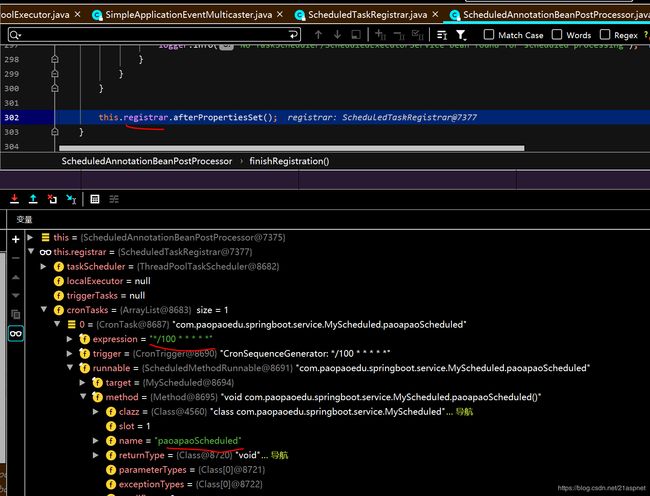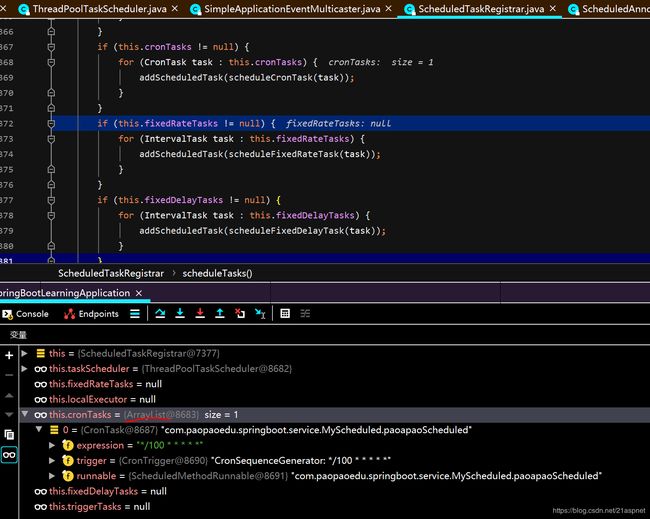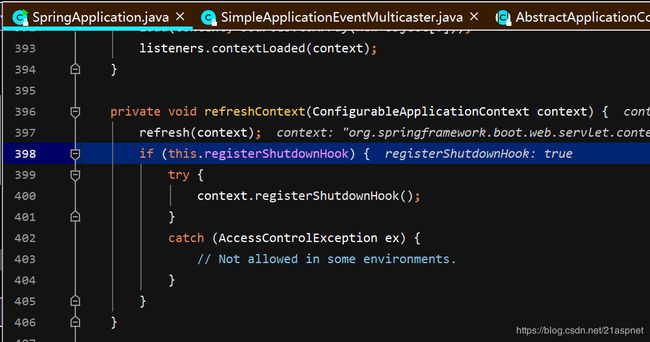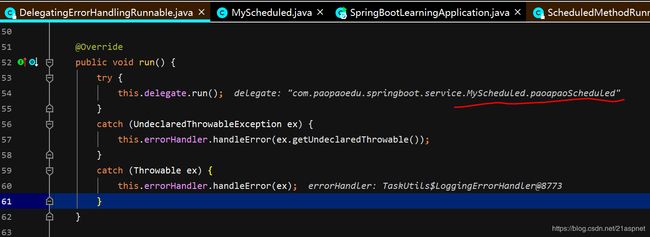SpringBoot源码分析之@Scheduled
Springboot写上注解@Scheduled就可以实现定时任务,
这里对其源码做一点分析
@Service
public class MyScheduled {
@Scheduled(cron="${time.cron}")
void paoapaoScheduled() {
System.out.println("Execute at " + System.currentTimeMillis());
}
}配置文件100秒一次
time.cron=*/100 * * * * *
重要的类ScheduledAnnotationBeanPostProcessor
@Nullable
private BeanFactory beanFactory;private void finishRegistration() {
if (this.scheduler != null) {
this.registrar.setScheduler(this.scheduler);
}
if (this.beanFactory instanceof ListableBeanFactory) {
Map beans =
((ListableBeanFactory) this.beanFactory).getBeansOfType(SchedulingConfigurer.class);
List configurers = new ArrayList<>(beans.values());
AnnotationAwareOrderComparator.sort(configurers);
for (SchedulingConfigurer configurer : configurers) {
configurer.configureTasks(this.registrar);
}
}
if (this.registrar.hasTasks() && this.registrar.getScheduler() == null) {
Assert.state(this.beanFactory != null, "BeanFactory must be set to find scheduler by type");
try {
// Search for TaskScheduler bean...
this.registrar.setTaskScheduler(resolveSchedulerBean(this.beanFactory, TaskScheduler.class, false));
}
catch (NoUniqueBeanDefinitionException ex) {
logger.trace("Could not find unique TaskScheduler bean", ex);
try {
this.registrar.setTaskScheduler(resolveSchedulerBean(this.beanFactory, TaskScheduler.class, true));
}
catch (NoSuchBeanDefinitionException ex2) {
if (logger.isInfoEnabled()) {
logger.info("More than one TaskScheduler bean exists within the context, and " +
"none is named 'taskScheduler'. Mark one of them as primary or name it 'taskScheduler' " +
"(possibly as an alias); or implement the SchedulingConfigurer interface and call " +
"ScheduledTaskRegistrar#setScheduler explicitly within the configureTasks() callback: " +
ex.getBeanNamesFound());
}
}
}
catch (NoSuchBeanDefinitionException ex) {
logger.trace("Could not find default TaskScheduler bean", ex);
// Search for ScheduledExecutorService bean next...
try {
this.registrar.setScheduler(resolveSchedulerBean(this.beanFactory, ScheduledExecutorService.class, false));
}
catch (NoUniqueBeanDefinitionException ex2) {
logger.trace("Could not find unique ScheduledExecutorService bean", ex2);
try {
this.registrar.setScheduler(resolveSchedulerBean(this.beanFactory, ScheduledExecutorService.class, true));
}
catch (NoSuchBeanDefinitionException ex3) {
if (logger.isInfoEnabled()) {
logger.info("More than one ScheduledExecutorService bean exists within the context, and " +
"none is named 'taskScheduler'. Mark one of them as primary or name it 'taskScheduler' " +
"(possibly as an alias); or implement the SchedulingConfigurer interface and call " +
"ScheduledTaskRegistrar#setScheduler explicitly within the configureTasks() callback: " +
ex2.getBeanNamesFound());
}
}
}
catch (NoSuchBeanDefinitionException ex2) {
logger.trace("Could not find default ScheduledExecutorService bean", ex2);
// Giving up -> falling back to default scheduler within the registrar...
logger.info("No TaskScheduler/ScheduledExecutorService bean found for scheduled processing");
}
}
}
this.registrar.afterPropertiesSet();
}
bean
找到自定义的MyScheduled
这里先逆向找到可见代码,再往上找到他的赋值地方
if (this.registrar.hasTasks() && this.registrar.getScheduler() == null) {
Assert.state(this.beanFactory != null, "BeanFactory must be set to find scheduler by type");
try {
// Search for TaskScheduler bean...
this.registrar.setTaskScheduler(resolveSchedulerBean(this.beanFactory, TaskScheduler.class, false));
}
catch (NoUniqueBeanDefinitionException ex) {
logger.trace("Could not find unique TaskScheduler bean", ex);
try {
this.registrar.setTaskScheduler(resolveSchedulerBean(this.beanFactory, TaskScheduler.class, true));
}
重要类ScheduledThreadPoolExecutor
参考:https://www.jianshu.com/p/502f9952c09b
ScheduledThreadPoolExecutor继承了ThreadPoolExecutor,也就是说ScheduledThreadPoolExecutor拥有execute()和submit()提交异步任务的基础功能,ScheduledThreadPoolExecutor类实现了ScheduledExecutorService,该接口定义了ScheduledThreadPoolExecutor能够延时执行任务和周期执行任务的功能。
ScheduledThreadPoolExecutor也两个重要的内部类:DelayedWorkQueue和ScheduledFutureTask。可以看出DelayedWorkQueue实现了BlockingQueue接口,也就是一个阻塞队列,ScheduledFutureTask则是继承了FutureTask类,也表示该类用于返回异步任务的结果。
/**
* @throws RejectedExecutionException {@inheritDoc}
* @throws NullPointerException {@inheritDoc}
*/
public ScheduledFuture schedule(Runnable command,
long delay,
TimeUnit unit) {
if (command == null || unit == null)
throw new NullPointerException();
RunnableScheduledFuture t = decorateTask(command,
new ScheduledFutureTask(command, null,
triggerTime(delay, unit)));
delayedExecute(t);
return t;
} 到了schedule这里:
增加定时任务ScheduledTaskRegistrar
protected void scheduleTasks() {
if (this.taskScheduler == null) {
this.localExecutor = Executors.newSingleThreadScheduledExecutor();
this.taskScheduler = new ConcurrentTaskScheduler(this.localExecutor);
}
if (this.triggerTasks != null) {
for (TriggerTask task : this.triggerTasks) {
addScheduledTask(scheduleTriggerTask(task));
}
}
if (this.cronTasks != null) {
for (CronTask task : this.cronTasks) {
addScheduledTask(scheduleCronTask(task));
}
}
if (this.fixedRateTasks != null) {
for (IntervalTask task : this.fixedRateTasks) {
addScheduledTask(scheduleFixedRateTask(task));
}
}
if (this.fixedDelayTasks != null) {
for (IntervalTask task : this.fixedDelayTasks) {
addScheduledTask(scheduleFixedDelayTask(task));
}
}
}遍历arrayList
跳出refresh
Spring如何添加钩子函数
这里没有注册钩子函数自然是null
进Runtime.getRuntime().addShutdownHook(this.shutdownHook);
终于完了
============================
触发定时
倒着看就知道怎么调用的,实际上是反射执行上述方法的:
invoke方法用来在运行时动态地调用某个实例的方法
这里实行了Runnable 接口:
反射,线程,线程池 底层还是这些技术!需要好好研究这块代码,加深理解基本原理。
扩展信息:SpringBoot中定时任务默认是串行执行 如何设置并行
SpringBoot 使用@Scheduled注解配置串行、并行定时任务
Spring Boot 中实现定时任务的两种方式

